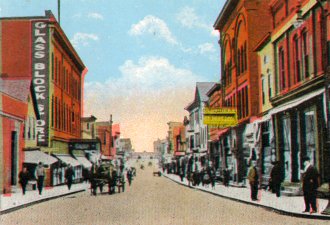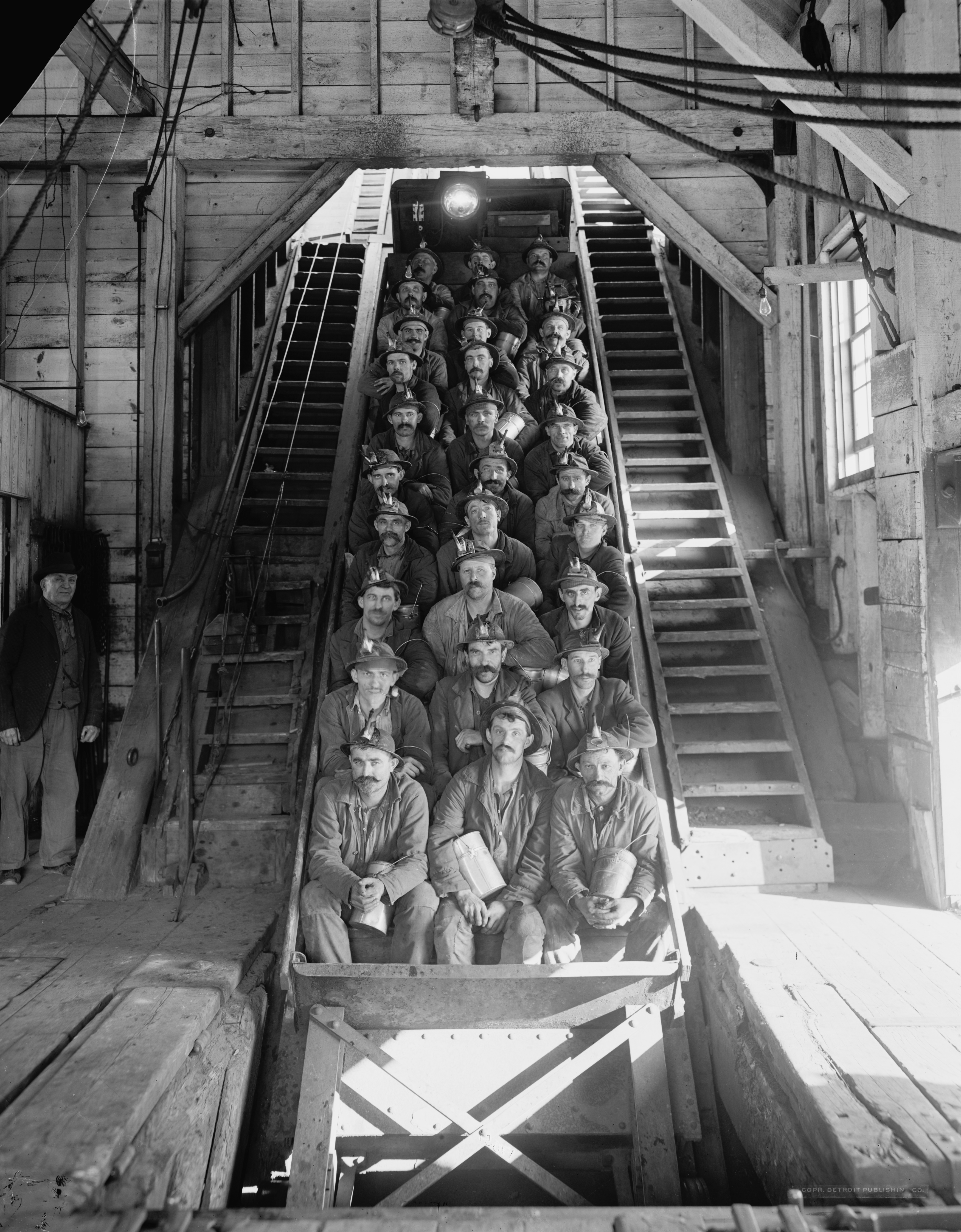|
Calumet, Michigan
Calumet ( or ) is a Village (United States), village in the Upper Peninsula of Michigan, Upper Peninsula of the U.S. state of Michigan. The village is located within Calumet Charter Township, Michigan, Calumet Township, Houghton County, Michigan, Houghton County, and had a population of 621 at the 2020 United States census, 2020 census. Calumet was once the center of Michigan's Copper mining in Michigan, copper mining industry. The village is home to a unit of Keweenaw National Historical Park, and also includes the Calumet Downtown Historic District, listed on the National Register of Historic Places (NRHP). Most of the village itself is also included within the Calumet Historic District, a larger area which is NRHP-listed and which is a National Historic Landmark District. History What is now Calumet was settled in 1864, originally under the name of Red Jacket, for a Native Americans in the United States, Native American Chief of the Seneca tribe. Until 1895 the name "Ca ... [...More Info...] [...Related Items...] OR: [Wikipedia] [Google] [Baidu] |
Village (United States)
In the United States, the meaning of village varies by geographic area and legal jurisdiction. In formal usage, a "village" is a type of administrative division at the local government in the United States, local government level. Since the Tenth Amendment to the United States Constitution prohibits the federal government from legislating on local government, the U.S. state, states are free to have political subdivisions called "villages" or not to and to define the word in many ways. Typically, a village is a type of municipality, although it can also be a special-purpose district, special district or an unincorporated area. It may or may not be recognized for governmental purposes. In informal usage, a U.S. village may be simply a relatively small clustered human settlement without formal legal existence. In colonial New England, a village typically formed around the church building, meetinghouses that were located in the center of each New England town, town.Joseph S. Wood ( ... [...More Info...] [...Related Items...] OR: [Wikipedia] [Google] [Baidu] |
Calumet Downtown Historic District
The Calumet Downtown Historic District is a historic district located in Calumet, Michigan, on 5th Street and 6th Street, between Scott Street and Pine Street. It is also known as the Red Jacket Downtown Historic District, reflecting the original name of the village. The Historic District is completely contained in the Calumet Historic District (a National Historic Landmark District) and the Keweenaw National Historical Park. It was designated a Michigan State Historic Site in 1973 and listed on the National Register of Historic Places in 1974. Three historic buildings on the 100 block of 5th street were destroyed in a fire that took place on May 22, 2021 History The village of Calumet, then known as "Red Jacket," was originally settled in 1864, and was incorporated in 1867. Calumet was an offshoot of the Calumet and Hecla Mining Company The Calumet and Hecla Mining Company was a major copper-mining company based within Michigan, Michigan's Copper Country. In the 19th centu ... [...More Info...] [...Related Items...] OR: [Wikipedia] [Google] [Baidu] |
Calumet Township, Michigan
Calumet Township ( ), officially the Charter Township of Calumet, is a charter township of Houghton County in the Upper Peninsula of the U.S. state of Michigan. The population was 6,263 at the 2020 census. Even with a decreasing population, the township remains the largest township by population in Houghton County. History Native Americans have mined native copper in Calumet Township beginning thousands of years ago. Calumet Township was created on 27 November 1866 at the Houghton County Clerk's Office; however, the Township did not hold its first meeting until Monday, 17 December 1866 at what was then the headquarters of the Calumet Mining Company. The Wolverine Mine opened in 1882. Large-scale production began in 1890. The mine closed in 1925. The old Wolverine Mine is famous among mineral collectors for copper, silver, epidote, and quartz specimens. Communities Within the Charter Township are the communities of: *Albion Station is an unincorporated community, south of ... [...More Info...] [...Related Items...] OR: [Wikipedia] [Google] [Baidu] |
Farming
Agriculture encompasses crop and livestock production, aquaculture, and forestry for food and non-food products. Agriculture was a key factor in the rise of sedentary human civilization, whereby farming of domesticated species created food surpluses that enabled people to live in the cities. While humans started gathering grains at least 105,000 years ago, nascent farmers only began planting them around 11,500 years ago. Sheep, goats, pigs, and cattle were domesticated around 10,000 years ago. Plants were independently cultivated in at least 11 regions of the world. In the 20th century, industrial agriculture based on large-scale monocultures came to dominate agricultural output. , small farms produce about one-third of the world's food, but large farms are prevalent. The largest 1% of farms in the world are greater than and operate more than 70% of the world's farmland. Nearly 40% of agricultural land is found on farms larger than . However, five of every six far ... [...More Info...] [...Related Items...] OR: [Wikipedia] [Google] [Baidu] |
Dairy
A dairy is a place where milk is stored and where butter, cheese, and other dairy products are made, or a place where those products are sold. It may be a room, a building, or a larger establishment. In the United States, the word may also describe a dairy farm or the part of a mixed farm dedicated to milk for human consumption, whether from cows, buffaloes, goats, yaks, sheep, horses or camels. The attributive ''dairy'' describes milk-based products, derivatives, and processes, and the animals and workers involved in their production, for example dairyman, dairymaid, dairy cattle or dairy goat. A dairy farm produces milk and a dairy factory processes it into a variety of dairy products. These establishments constitute the global dairy industry, part of the food industry. The word ''dairy'' comes from an Old English word for ''female servant'', as milking was historically done by dairymaids. Terminology Terminology differs between countries. In the United States, for ex ... [...More Info...] [...Related Items...] OR: [Wikipedia] [Google] [Baidu] |
Calumet And Hecla Mining Company
The Calumet and Hecla Mining Company was a major copper-mining company based within Michigan, Michigan's Copper Country. In the 19th century, the company paid out more than $72 million in shareholder dividends, more than any other mining company in the United States during that period. History In 1864, Edwin J. Hulbert discovered a copper-bearing section of what became known as the Calumet Conglomerate dating back to the Precambrian age. The find was in Houghton County, Michigan, between the rich Cliff mine to the northeast, and the copper mines of Portage Lake (Keweenaw), Portage Lake to the southwest, but a long way from either. Hulbert formed the Hulbert Mining Company in 1864 to acquire the land rights, before creating the Calumet Company in 1865, with investment capital from Boston. The company spun off the Hecla Company the following year, and assigned shares in the new company to Calumet shareholders. Hulbert was a major shareholder in both companies, and was in charge of ... [...More Info...] [...Related Items...] OR: [Wikipedia] [Google] [Baidu] |
Laurium, Michigan
Laurium (; or ) is a village in Calumet Township, Houghton County in the U.S. state of Michigan, in the center of the Keweenaw Peninsula. The population was 1,977 at the 2010 census. The village is mostly surrounded by Calumet Township, with a small portion bordering Schoolcraft Township on the east. The portion of Calumet Township south of Laurium is considered part of the Florida (or Florida Location) unincorporated community. History Until 1895, Laurium was known as "Calumet" (not to be confused with the present nearby town of Calumet, Michigan, which was known as "Red Jacket" until it adopted the name Calumet in 1929). In 1895 the legislature changed Calumet's name to Laurium, after the famous mining town in ancient Greece. Laurium is located in the center of the Copper Country, the first major copper mining region in the United States. It was founded as a company town serving the Laurium copper mine, which later became part of the Calumet & Hecla mine. The town w ... [...More Info...] [...Related Items...] OR: [Wikipedia] [Google] [Baidu] |
Seneca Tribe
The Seneca ( ; ) are a group of indigenous peoples of the Americas, Indigenous Iroquoian languages, Iroquoian-speaking people who historically lived south of Lake Ontario, one of the five Great Lakes in North America. Their nation was the farthest to the west within the Six Nations or Iroquois, Iroquois League (Haudenosaunee) in New York before the American Revolution. For this reason, they are called “The Keepers of the Western Door.” In the 21st century, more than 10,000 Seneca live in the United States, which has three federally recognized Seneca tribes. Two of them are centered in New York: the Seneca Nation of Indians, with five territories in western New York near Buffalo, New York, Buffalo; and the Tonawanda Band of Seneca, Tonawanda Seneca Nation. The Seneca-Cayuga Nation is in Oklahoma, where their ancestors were relocated from Ohio during the Indian Removal. Approximately 1,000 Seneca live in Canada, near Brantford, Ontario, at the Six Nations of the Grand River Fir ... [...More Info...] [...Related Items...] OR: [Wikipedia] [Google] [Baidu] |
Native Americans In The United States
Native Americans (also called American Indians, First Americans, or Indigenous Americans) are the Indigenous peoples of the Americas, Indigenous peoples of the United States, particularly of the Contiguous United States, lower 48 states and Alaska. They may also include any Americans whose origins lie in any of the indigenous peoples of North or South America. The United States Census Bureau publishes data about "American Indians and Alaska Natives", whom it defines as anyone "having origins in any of the original peoples of North and South America ... and who maintains tribal affiliation or community attachment". The census does not, however, enumerate "Native Americans" as such, noting that the latter term can encompass a broader set of groups, e.g. Native Hawaiians, which it tabulates separately. The European colonization of the Americas from 1492 resulted in a Population history of Indigenous peoples of the Americas, precipitous decline in the size of the Native American ... [...More Info...] [...Related Items...] OR: [Wikipedia] [Google] [Baidu] |
Red Jacket
Red Jacket (known as ''Otetiani'' lways Readyref name=parkerxxiii>Parker 1952, Preface p. xxiii. in his youth and ''Sagoyewatha'' eeper Awake''Sa-go-ye-wa-tha'' as an adult because of his oratorical skills) ( – January 20, 1830) was a Seneca orator and chief of the Wolf clan, based in Western New York. On behalf of his nation, he negotiated with the new United States after the American Revolutionary War, when the Seneca as British allies were forced to cede much land following the defeat of the British; he signed the Treaty of Canandaigua (1794). He helped secure some Seneca territory in New York state, although most of his people had migrated to Canada for resettlement after the Paris Treaty. Red Jacket's speech on "Religion for the White Man and the Red" (1805) has been preserved as an example of his great oratorical style. Life Red Jacket's birthplace has long been a matter of debate. Some historians claim he was born about 1750 at '' Kanadaseaga'', also known as the Old ... [...More Info...] [...Related Items...] OR: [Wikipedia] [Google] [Baidu] |






